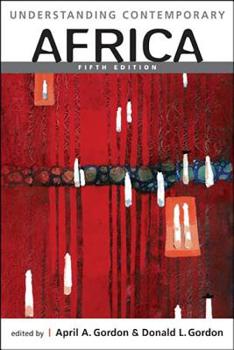Understanding Contemporary Africa
Select Format
Select Condition 
Book Overview
The sixth edition of Understanding Contemporary Africa, and the first under the editorship of Peter Schraeder, combines the historic strengths of the previous editions with coverage of new topics... This description may be from another edition of this product.
Format:Hardcover
Language:English
ISBN:1588268470
ISBN13:9781588268471
Release Date:October 2012
Publisher:Lynne Rienner Publishers
Length:511 Pages
Weight:1.60 lbs.
Dimensions:1.0" x 6.0" x 8.9"
Customer Reviews
2 ratings
An Excellent Introduction to a Fascinating Continent
Published by Thriftbooks.com User , 19 years ago
I loved this book. It's extremely well-written, sensitive, and demonstrates a wealth of knowledge about African cultures, politics, religions, economies, gender relations, and, in one of the best chapters in the book, literature. You don't often see such a skillful sketch of the impressive African novels and poems that have been written in the past few generations. This is the perfect book to assign to students who have no exposure to anything African (which, unfortunately, is most undergraduates). Although it's an introduction to the topic, those who know a great deal about it will find that almost all of it resonates with the other literature they have read, whether historical, political, or otherwise. It's a very compassionate and progressive look at Africa. All modern challenges to the continent are presented so that students get a multi-dimensional look at Africa's struggles. Environmental and agricultural problems are presented in tandem with economic and political ones, so that students will have a real context in which to put all future readings about Africa. But unlike so many African books, the text provides sections such as the one on literature, to show that Africa has many achievements, instead of focusing only on negativity, as unfortunately many books on the topic do. At the same time, it does not gloss over the tragedies on the continent and their causes, and difficult topics such as the AIDS crisis are treated in a sensitive manner. It is a great book and I can't imagine there's one better out there. However, were I to make suggestions to the editors they would be the following: 1. The historical section could be slightly larger. The historical context is dealt with in one chapter, and yet a more extensive discussion of certain historical events would help students better understand some of the continent's present difficulties. 2. The literature section could be extended to include popular culture, music, every day entertainments, festivals, etc. Students would enjoy some additional stories showing the richness of so many African cultures. Although the literature section does this, it could do so more thoroughly. 3. The economic section would benefit from more success stories. Although it has an excellent discussion of the crushing debt burden and the role of international financial institutions in African economies, which students must know about, it would help to see some dicussions not just of how local business and initiative is stifled, but descriptions of these businesses. I've read some fascinating things about African entrepreneurship and ingenuity in industry against all kinds of odds. Although many of these efforts were stifled by the state, I think students would benefit from knowing about dynamic efforts such as these. 3
Understanding Contemporary Africa
Published by Thriftbooks.com User , 23 years ago
Understanding Contemporary Africa is a general textbook that is perfect for introductory courses in African studies. Authors of the various chapters are university-level scholars and teachers of history, political science, sociology, religion, and African studies. The subjects covered are African history, politics, national economies, international relations, population growth and urbanization, the environment, familial structures, women's effect in society, religion, and literature. There is an entire chapter devoted to South Africa.This book contains many helpful references. Full page maps are near the beginning of the book, showing major physical features, the ITCZ and vegetation zones, natural resources compared to railroads and navigable rivers, early states and empires, colonies in 1914, and current countries and their capitals. I needed to refer to them often enough that I put a paperclip on the pages. Table 5.1 is a current export chart. Each chapter ends in a lengthy bibliography for further study. At the end of the book, acronyms are defined and there is a thorough glossary to which I referred many times. Basic Political Data is the third appendix. Each country is traced from independence to the present day in terms of its leaders. Although the book suffers from sweeping generalizations, many times these are acknowledged by the authors. There are too few examples of these generalizations for my own taste. I personally prefer more "real people" stories to demonstrate points being made. This does not detract from the excellence of this intended introductory textbook for college-level African studies courses. The last chapter of the book leaves the reader on the upbeat. There is hope for Africa in the current generation of young, educated middle and upper class men and women. They are seeing a bright future for Africa with hope in place of despair. Autocrats are being replaced with democratic leaders. Small businesses are on the rise; this is always a healthy sign in an economy. Health services and public education have increased since independence. The book closes with the observation that it will take a world partnership with Africa to make things work to neutralize the long term effects of exploitation of the African continent.






